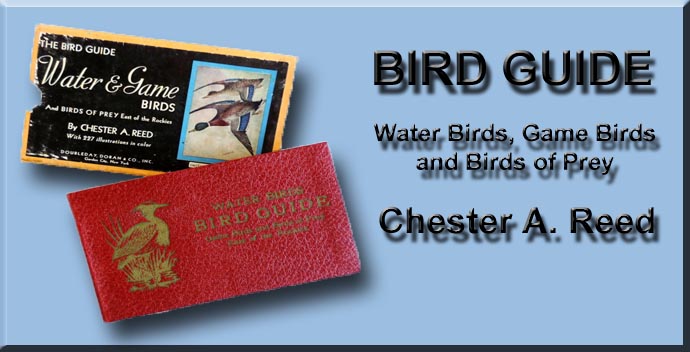
BIRD GUIDE
Water Birds, Game Birds and Birds of Prey
By Chester A. Reed
Introduction
|
|
|
The study of the birds included in this book is much more difficult than that of the small land birds. Many of the birds are large; some are very rare; all are usually shy and have keen eyesight, trained to see at a distance; in fact, many of them have to depend upon their vigilance for their very existence. Therefore, you will find that the majority of these birds will have to be studied at long range. Sometimes, by exercising care and forethought, you may be able to approach within a few feet of the bird you seek, or induce him to come to you. It is this pitting your wits against the cunning of the birds that furnishes one-half of the interest in their study. Remember that a quick motion will always cause a bird to fly. If you seek a flock of plover on the shore, or a heron in the marsh, try to sneak up behind cover if possible; if not, walk very slowly, and with as little motion as possible, directly towards them; by so doing you often will get near, for a bird is a poor judge of distance, while a single step sideways would cause him to fly. Shore birds can usually be best observed from a small "blind," near the water's edge, where they feed. Your powers of observation will be increased about tenfold if you are equipped with a good pair of field glasses; they are practically indispensable to the serious student and add greatly to the pleasures of anyone. Any good glass, that has a wide field of vision and magnifies three or four diameters, is suitable; we can recommend the ones described in the back of this book. WHAT TO MAKE NOTE OF. -- What is the nature of the locality where seen; marsh, shore, woods, etc? If in trees does it sit upright or horizontal? If on the ground, does it run or walk, easily or with difficulty? If in the water, can it swim well, can it dive, does it swim under water, can it fly from the water easily, or does it have to patter over the surface before flying? What does it seem to be eating? Does it have any notes? Does it fly rapidly; with rapid wing beats or not; in a straight line or otherwise? Does it sail, or soar? In flocks or singly? These and hundreds of other questions that may suggest themselves, are of great interest and importance A PLEA TO SPORTSMEN. -- Many of the birds shown in this book are Game Birds, that is, birds that the law allows you to shoot at certain seasons of the year. Some of these are still abundant and will be for numbers of years; others are very scarce and if they are further hunted, will become entirely exterminated in two or three years. Bob-whites are very scarce in New England; Prairie Hens are becoming scarce in parts of the west; the small Curlew is practically extinct, while the larger ones are rapidly going. In behalf of all bird lovers, we ask that you refrain from killing those species that you know are rare, and use moderation in the taking of all others. We also ask that you use any influence that may be yours to further laws prohibiting all traffic in birds. The man who makes his living shooting birds will make more, live longer and die happier tilling the soil than by killing God's creatures. We do not, now, ask you to refrain from hunting entirely, but get your sport at your traps. It takes more skill to break a clay pigeon than to kill a quail.
|
 |
 |
|
|
|
-
Site Navigation
 Home
Home What's New
What's New Bible
Bible Photos
Photos Hiking
Hiking E-Books
E-Books Genealogy
Genealogy Profile
Free Plug-ins You May Need
Profile
Free Plug-ins You May Need
 Get Java
Get Java.png) Get Flash
Get Flash Get 7-Zip
Get 7-Zip Get Acrobat Reader
Get Acrobat Reader Get TheWORD
Get TheWORD
